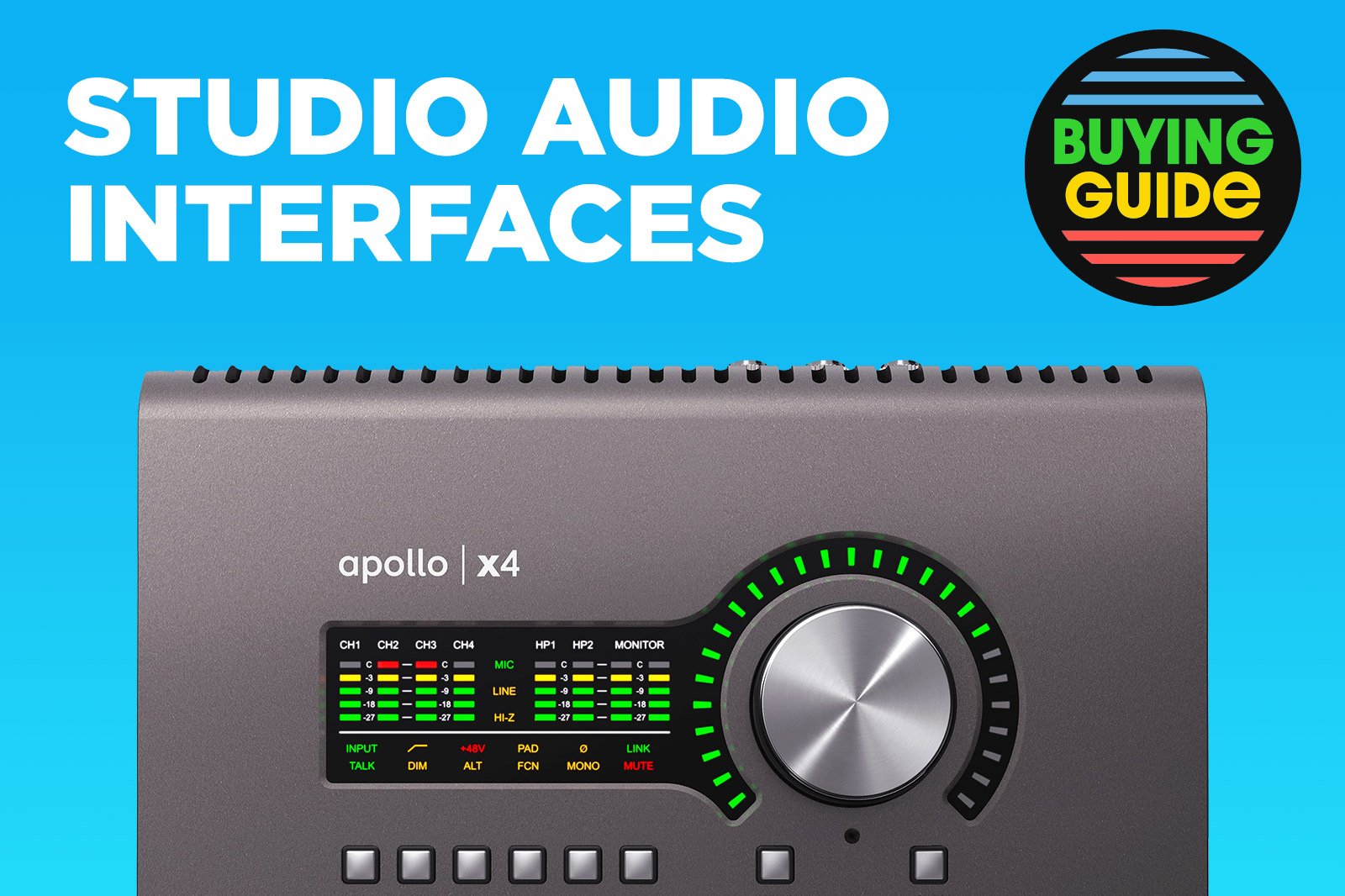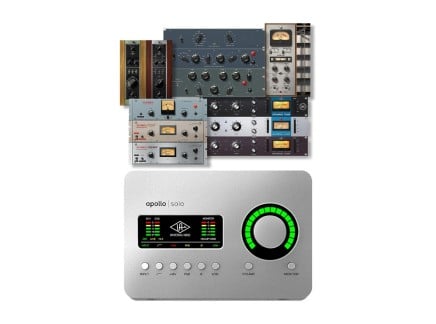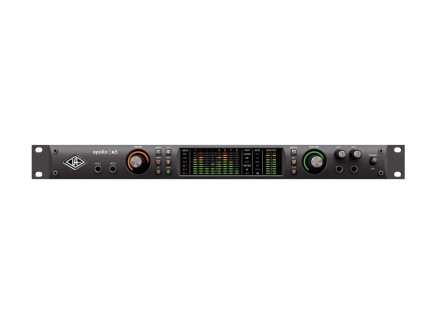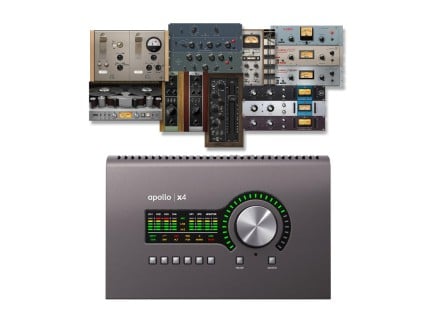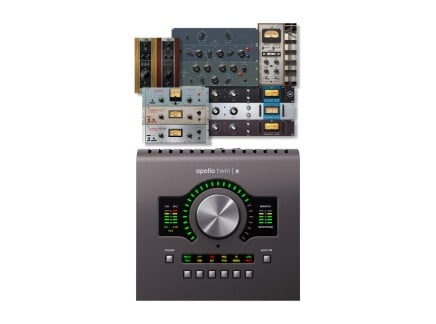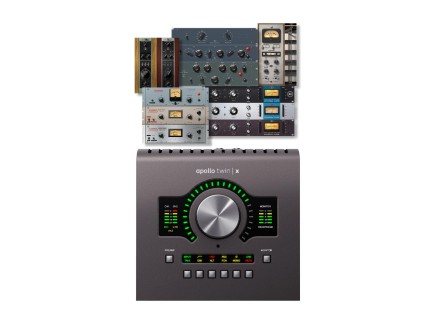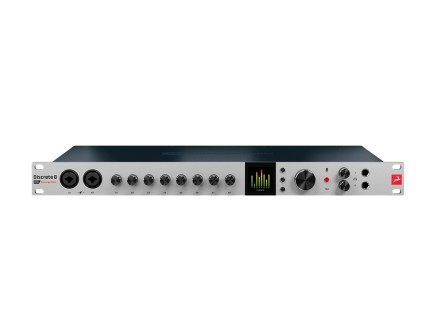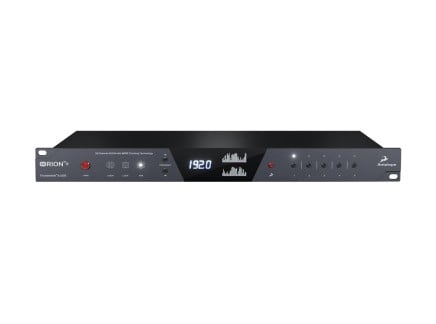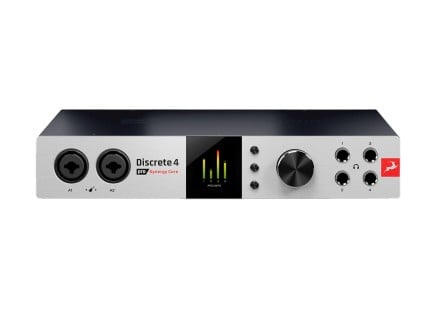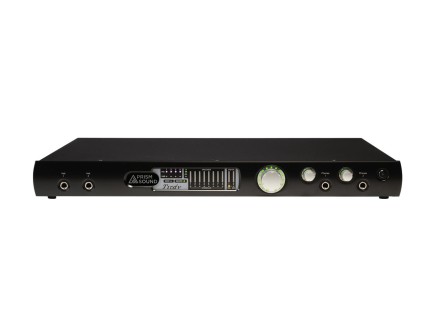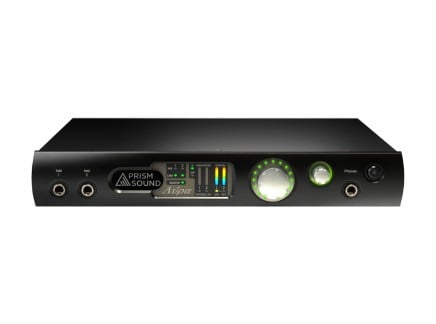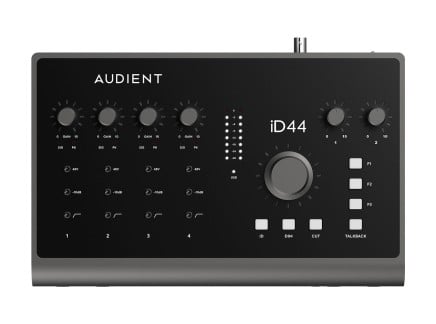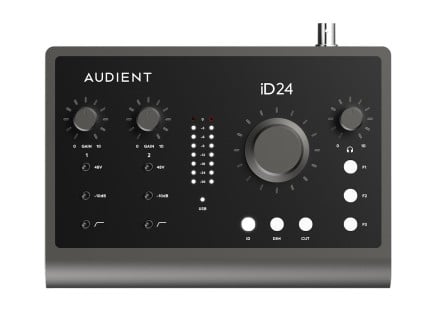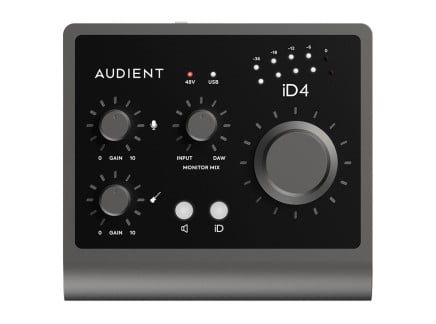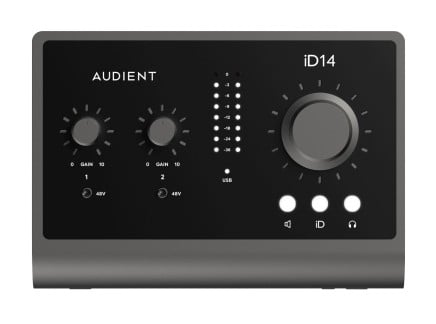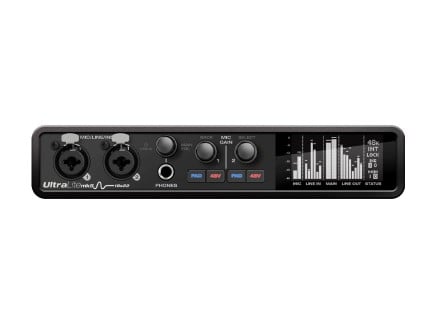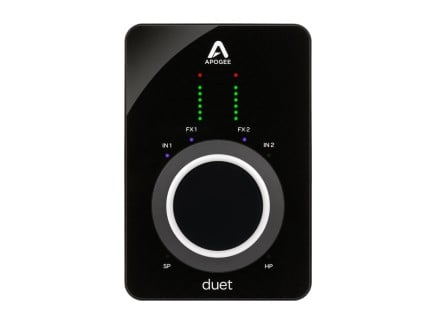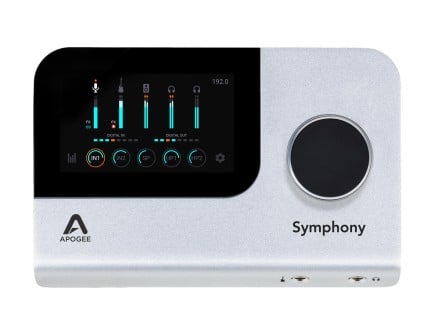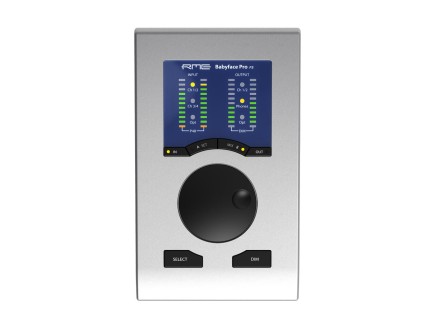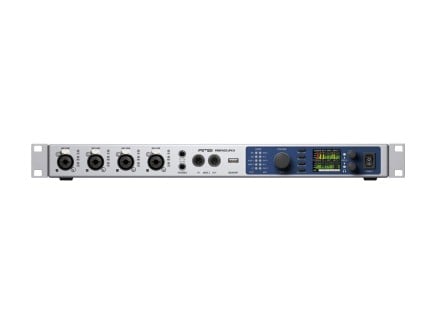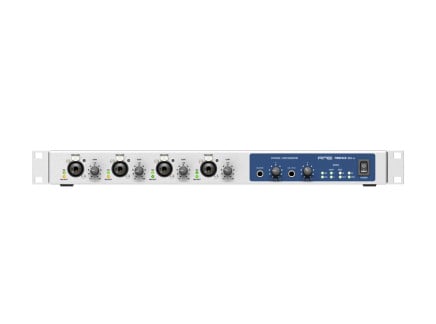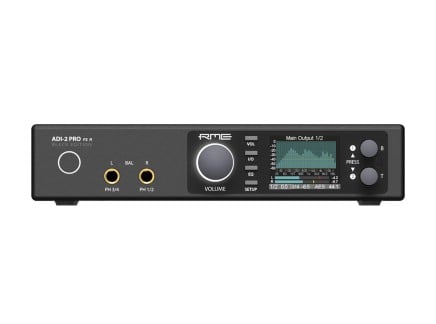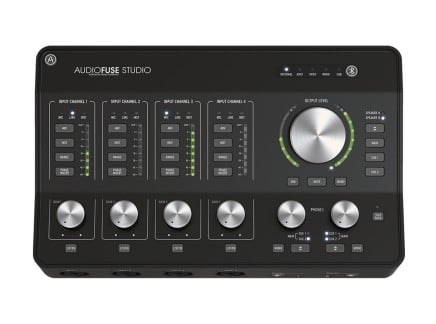Audio interfaces are the center of any modern recording studio. They're the thing that allows you to capture sound into your computer, the thing that allows you to hear your creations—and in many cases, their internal converters and preamps play a huge role in determining the overall quality of your sound.
We previously covered our favorite audio interfaces under $500...all of which would make an excellent start into your journey as a recording musician, and many of which could serve you for years to come in your home studio or performance rigs. In this article, though, we're setting our sights higher. This is a list of our favorite audio interfaces for building a high-end, professional recording practice. Some still bear a portable/compact form factor; others are multi-channel workhorses designed to sit at the center of pro recording rigs. Some use FPGA technology to re-factor the behavior of their preamps; some feature internal DSP for running state-of-the-art, high-quality plug-in emulations of vintage consoles and recording equipment.
One thing is certain: no matter which of these you choose, your recordings are sure to gain a sense of depth, clarity, and life difficult to achieve with other gear. That in mind, let's dive right in and take a look at our top picks for studio-quality audio interfaces.
Universal Audio Apollo Series: The Whole Package
The Apollo series from Universal Audio features a range of uncompromisingly high-quality audio interfaces, with options suitable for smaller streamlined project studios, large-scale production hubs, and everything in between. In fact, several of us at Perfect Circuit (and on the Signal staff) rely on these interfaces as the center of our own home studios and performance setups. But what makes them so special?
Besides the impeccable AD/DA converters, 24-bit/192kHz resolution, huge dynamic range, low-latency recording, and an overall fantastic build and sound quality, what makes the Apollo interfaces truly special, is close integration with the company's renowned software plugins which can run directly on the interface's DSP hardware, thus alleviating a significant portion of processing strain from your machine. And with all of the interfaces are distributed as a Heritage Edition bundle, a decent selection of some of the most revered UAD plugins will be available to you right out of the box. (Of course, if you want to skip the plugin packages, even the non-heritage edition models offer a solid, albeit not quite so complete complement of UAD plugins so that you can get a taste of the UAD workflow.)
The series starts with the compact Apollo Solo interface, available in both USB (for Windows systems) and Thunderbolt 3 (for Apple systems) versions. Apollo Solo features a no-nonsense I/O configuration. It has two pre-amplifier inputs with Universal Audio's proprietary UNISON technology which can, almost magically, make them sound and behave like a variety of classic solid-state and tube amplifiers or unbelievably realistic guitar and bass amp emulations in real-time. A high impedance input for guitar signals is also available as an alternative on the first channel. The interface has two outputs, plus a dedicated headphone monitor output. This streamlined amalgamation of inputs and outputs makes Apollo Solo a perfect solution for artists and producers that work in smaller project studios, but don't wish to compromise on sound quality. Moreover, the interface is bus-powered, which makes it extra suitable for the creatives who travel or spend a lot of time working on the go.
Those of us who still value portability in an interface, but require extended connectivity options can confidently make a move towards Apollo Twin X or Apollo X4. Twin is very similar to Solo, but it offers two more output channels, and an optical input for external channel expansion via S/PDIF or ADAT. Apollo Twin X also comes in DUO or QUAD variety, with names indicating the number of DSP cores (versus the single core in, say, the Solo model). Apollo X4 takes it up a notch with four pre-amp inputs (Hi-Z alternatives on channels 1 and 2), six analog outputs, two headphone monitoring outs, as well as optical input and output ports—and four DSP cores.
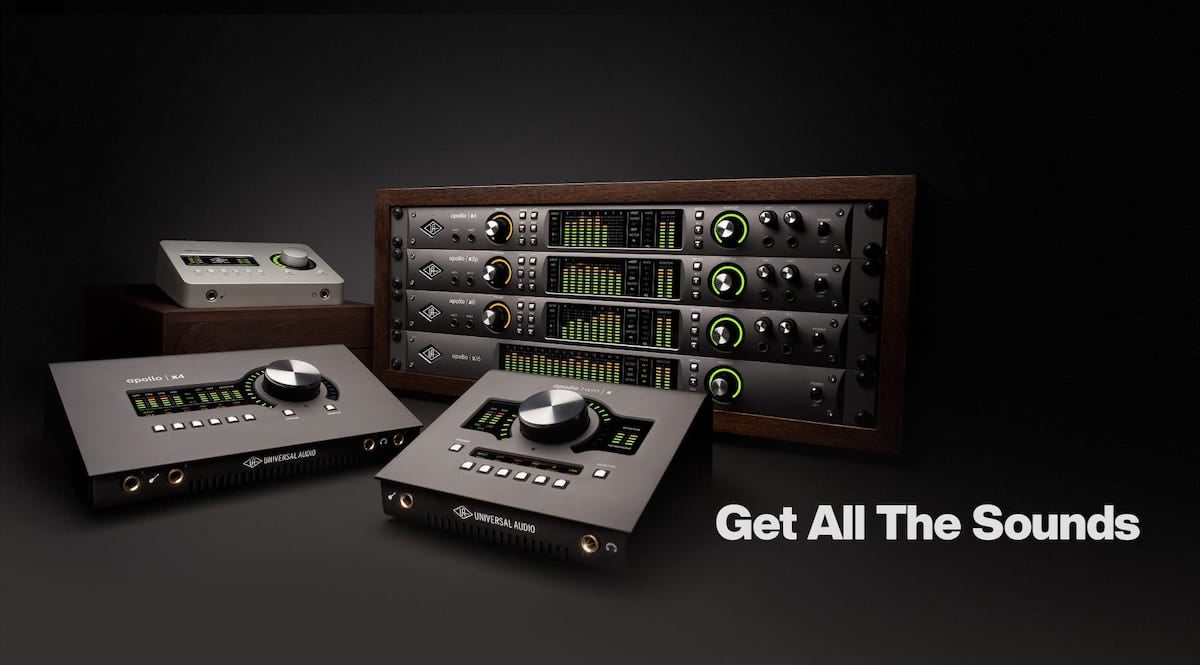
Next in the series are the rackmount Apollo interfaces, perfect for stationary studios of varied sizes and connectivity requirements. These are Apollo X6, Apollo X8, Apollo X8p, and Apollo X16. As you may guess, the higher the number after the "X", the more connection ports are available on the interface, but there are some other distinctions. Note that all of the rackmount Apollo X models offer a whopping six DSP cores, great for complex mixing sessions and processing arrangements.
Apollo X6 features two UNISON mic preamps / Hi-Z inputs, six line-level inputs, eight analog outputs, S/PDIF I/O via RCA plugs, and a pair of optical input and output ports. Apollo X8 differs in that it has four preamps (with Hi-Z on channels 1 and 2), eight line inputs, and ten analog outputs. The configuration on Apollo X8p is slightly different, as it maximizes the preamp count with eight UNISON-enabled channels—each with dedicated combo jack inputs for mic or line level input (and again, Hi-Z on channels 1 and 2). It additionally offers line input via DB25, and all line outputs are accessed via DB-25 ports. This helps in preserving the same sleek 1U form factor while increasing the channel count of the interfaces.
This is also the case with Apollo X16, which offers all of its sixteen analog inputs and sixteen analog outputs via DB-25 connection, and in place of optical ports, this interface provides digital connection via AES/EBU standard. So, while it does have XLR main monitor outputs, all other I/O needs to be handled via DB25 breakouts or connection to external patchbays/500 Series racks/etc. It's important to note that, as such, X16 also foregoes the Unison preamps found on other models, and only features line-level input: so if you're a studio using outboard preamps or 500 Series pres as a frontend for recording, it could be a perfect choice. It is also important to note that all of the rackable Apollo interfaces feature Word Clock I/O and two Thunderbolt 3 ports.
As you can see, whatever your production or recording needs are, there is likely an Apollo interface that will be just right for you. Most of these audio interfaces are expandable, so you can always update your setup as your creative needs change. And of course, remember that buying into the Apollo workflow means that you're also gaining access to countless top-notch, award-winning UAD plugins. Some crowd favorites include a faithful recreation of the Ampex ATR-102 tape machine, SSL console channel strips, EMT plate reverbs, and much more. It's a rich ecosystem sure to take your productions up a notch. And again—the Apollo X racks all offer multiple Thunderbolt ports, making it possible to expand by adding yet another Apollo interface to your setup, seamlessly combining their I/O. So even as your studio grows, there's a place for any model Apollo.
Antelope Audio: Interfaces for All Occasions
Known for creating incredibly reliable clocking and excellent converters, Antelope Audio has been working on a line of audio interfaces that bring professional sound to studios of all sizes. Whether you need top-shelf audio as a mastering studio, plenty of I/O for recording bands, or just DC-coupled outputs for your synthesizers, Antelope Audio has something for you. Their Zen lineup is a good place to start because of the variety and price point—with the Zen Go and Zen Q, you have portable, high-quality sound in a compact, bus-powered package (with either Thunderbolt or USB connectivity). With the Zen Tour, the highest level in this series, you exchange some portability for powerful DSP processing, expanded I/O, and it still can fit in your bag.
One of the main features that the Zen Tour (and other "Synergy Core" interfaces) offers is onboard processing, courtesy of two FPGA chips and four DSP chips. You have to use Antelope's library of plugins designed for the architecture, however, the list is quite robust and growing. There are several different ways to route these effects in. First, like standard external hardware you record the sound of the compressor, EQ, or channel strip directly into the track, "baking it in." You can also use virtual routing to send your entire project through a mastering setup you have concocted or create individual busses that can be routed to these effects. You can also use their afx2daw plugin which gives you access to the effects just like a VST. It is important to note that when you use these effects, you have to render the audio file in realtime.
Expandability is also a feature with the Zen Tour which gives you independent ADAT and SPDIF connections so you can easily connect it to other pieces that use this format, however, using a DB25 breakout cable, you have eight independent balanced line outputs, all of which are DC-coupled. If you use modular equipment, you can now use Ableton's CV Tools, Expert Sleepers software, and other programs that let you generate CV from your computer. Do keep in mind that because they are balanced you will need floating ring cables to properly access the CV signals.
Recently updated, Antelope Audio's Discrete Pro line of audio interfaces pairs console-style input preamps with their highly regarded converters, clocking, and Synergy Core technologies. The smaller of the two interfaces in this family, the Discrete 4 Pro Synergy Core, is compact enough to sit on a desk or slip into a mobile recording rig, but don't allow its size to cast any doubts on its capabilities. Four discrete preamps with a six-transistor design provide a dash of analog flavor, while a set of four auxiliary line outputs offer options for routing out to hardware pieces, alternative monitoring, and more. Besides your choice of USB or Thunderbolt 3 connection, there are also dual word clock outputs, ADAT optical I/O, and S/PDIF I/O for easy expansion when you need more recording channels.
Of course, if you need a bit more, Antelope's Discrete 8 Pro Synergy Core offers twice as many preamps as its smaller counterpart, but there's more to the story than the channel count. While the eight line outputs have been condensed down to a single DB25 connector, the Discrete 8 Pro offers two dedicated reamp outputs on 1/4" TRS jacks. These outputs allow for impedance-correct processing of guitar or other instrument signals through amps or effects, but can also be used as a secondary pair of monitor outputs. The Discrete 8 Pro also supports more ADAT channels, and boasts additional word clock outputs to further tie your studio together.
Antelope Audio's offerings extend well up into the professional ranges that top studios require, and that includes audio interfaces like the Orion 32+ | Gen 3 and Galaxy 32 Synergy Core. As far as specs are concerned, these are both highly stacked interfaces with abundant analog I/O on D-SUB 25 connectors, Antelope's pristine Acoustically Focused Clocking technology, as well as onboard effects processing with the Orion's FPGA platform and the Galaxy's Synergy Core implementation. But while they might seem similar, each of these interfaces fits into its own niche.
Based on the name alone, you might think the Orion 32+ | Gen 3 is a 32-channel audio interface, and while it is when connected via USB, grab a Thunderbolt 2 cable and that channel count doubles to 64. Channels aside, you'd probably want to use Thunderbolt anyways because by leveraging the Orion's premium AD/DA converters and expertly engineered drivers it's possible to achieve ultra-low roundtrip latency while tracking into your DAW. Couple this with additional digital connectivity via MADI, ADAT, and S/PDIF I/O plus dual Word Clock outputs, Orion 32+ can handle anything that you throw at it.
At a glance, the Galaxy 32 Synergy Core looks a lot like the Orion 32+, but the differences lie in a few key areas. While the analog audio I/O channel count remains the same at 32 channels of inputs and outputs each, digital connectivity has been expanded to support Pro Tools HDX and Dante systems, affording more possibilities for studios where sophisticated recording rigs require clean integration and top-tier routing flexibility. And when you consider the additional benefits of onboard Synergy Core effects processing, handy routing presets, and standalone operation, the Galaxy 32 could be the multi-purpose audio interface that your studio needs.
Prism Sound: for When You Need the Best, Period
While they may not carry the same name recognition in the "prosumer" area as some of the other brands we've mentioned, we can't give an honest assessment of the state of professional-grade audio interfaces without discussing Prism Sound: makers of the Lyra, Titan, and other world-class interfaces/converters. Having produced high-end converters and interfaces for years, Prism Sound more recently turn their sights to the creation of compact interfaces without compromising sound quality. That's how the Lyra was born.
The Lyra comes in two varieties: Lyra 1, and Lyra 2, each different primarily in I/O count. The Lyra 1 offers two A/D analog input channels; each of these offer 1/4" balanced or unbalanced input, and one offers an additional XLR input/preamp appropriate for use with microphones. It additionally offers two dedicated TRS output channels, and a single ADAT Optical Input and Output (so that you can expand with additional I/O as needed). The Lyra 2 expands on this potential, allowing 1/4" or XLR operation on both of its two A/D input channels, as well as four additional 1/4" line outputs for alternate monitor pairs, connection to outboard processors, and more. Additionally, Lyra 2 offers BNC word clock in/out connections, making it a breeze to synchronize with external word clock generators or other converters.
Our current favorite from Prism Sound's lineup is Titan: perhaps one of the classiest interfaces that we sell altogether. Boasting the same world-class converter technology as its smaller siblings, the Titan ups the analog I/O count to two 1/4" instrument inputs, four mic/line inputs with high-quality preamps, four additional line inputs, and eight analog line outputs. It still affords ADAT optical input and output, so you can double the I/O count if desired; and of course, it maintains the BNC word clock connectivity of the Lyra 2. If even offers an expansion port for connection to PTHD or Dante systems, and it's fully compatible with Mac or PC recording systems.
It's difficult to describe just how impeccable the Titan's conversion is—but rest assured, we'd feel comfortable recommending it for any recording scenario. So if you're an audio archivist, or if you're building a top-notch recording studio, or if you just need to be sure that your project studio has the best sound possible at all times—Titan is a stellar choice.
Worth note: all Prism interfaces support Verifile, a proprietary technology that allows computer audio streams and recorded audio to be quickly checked for typical undesirable artifacts like clicks, dropouts, or other issues. Quickly pointing out even the most minute of errors, this audio fidelity verification system is a must for mastering engineers, audio archivists, or others working in highly detail-oriented audio tasks. Additionally, the Lyra 1, Lyra 2, and Titan interfaces can also be purchased along with the Prism Sound Ultimate Collection, a bundle of over $4000 worth of premium virtual instruments, FX plugins, DAW, and a top-of-the-line mastering and edit suite. If you want to go all out and take advantage of everything Prism has to offer, be sure to check out the ultimate collection.
Compact, High Quality Sound: Audient iD44 MkII
Freshly updated, Audient's iD44 MkII improves upon an already solid interface and manages to make it even better! This interface packs console-quality sound into a tidy, desktop-sized package, on top of professional-grade converters, plenty of expandability, and workflow features perfectly suited for modern recording in home and project studios. But by also including contemporary features like hardware insert loops and audio loopback functionality, the iD44 MkII stands out as an interface that will appeal to musicians, engineers, podcasters, and audio content creators alike.
A big draw for the iD44 MkII is its rich analog circuitry, pulled straight from Audient's premier recording console designs. The four mic preamps are quiet and noise-free, but also provide a subtle flavor of analog warmth. Furthermore, the two instrument inputs feature JFET stages, emulating the behavior of tube amplifiers that have historically been the top choice for guitars and basses, but will work wonderfully on synths and other instruments, too. The first two channels also sport insert loops, meaning that you can place outboard effects like compressors and EQ after the iD44's preamps but before the converters. This is also a great way to get line-level signals into your DAW without coloration from the preamp.
Like any great interface, the iD44 is also highly expandable, thanks to its inclusion of optical I/O ports. Functioning as either S/PDIF or ADAT, you can add up to an additional 16 channels of audio to your interface! If you have a collection of existing preamps that you'd like to incorporate or see yourself needing more options down the road, iD44 MkII is an interface that can grow with you. There's also BNC Word Clock output to sync up other devices in your studio which require it.
Because they also have a history of building phenomenal recording consoles, Audient recognizes that audio recording and music production often benefits from a tactile experience. With that in mind, not only are the most important input channel controls laid out like a miniature mixing console, but three function buttons are assignable to advanced monitoring functions, and the large volume knob may even be used to control key parameters in compatible plugins and DAWs. You can also use your computer's built-in microphone as a talkback mic, keeping all of your channels free to record your talent.
At the end of the day, Audient designed the iD44 MkII to be a professional-grade, desktop interface adept at handling the wide variety of modern audio needs out there today. As more of us start to wear multiple creator hats, having gear that can keep up with us is crucial, and the iD44 MkII promises to do just that. And of course, if iD44 is more than you personally need, don't fret—the iD4, iD14, and iD24 provide the same sound quality and many of the same features with a reduced I/O count and lower price point.
Studio + Performance Workhorse: MOTU Ultralite Mk5
MOTU's Ultralite-mk5 is the latest and greatest entry in their line of audio interfaces with an unmatched ratio of size to features. Prior iterations of this interface are still used as the go-to choice for performing electronic musicians and producers, and it's also an excellent option to serve as a studio centerpiece. While it doesn't come with the price tag of some of the interfaces on this list, it does come along with unprecedented sound quality and a boatload of powerful features. This version packs some of the best converters ever used in a MOTU interface to date, and when considering the physical and software specifications, the UltraLite-mk5 is almost certainly one of their best yet.
On the surface, the UltraLite-mk5 is already an impressive audio interface when only considering its physical specs. Two front inputs accept microphones, instruments, or line level sources with ease, while six additional line inputs are found on the back. Continuing along the rear are a whopping ten line outputs, which means that you can easily drive a set of main monitors, secondary monitors, outboard gear and effects, or any other destination that needs a unique audio channel. As a bonus, like many of MOTU's other interfaces, these outputs are DC-coupled and may be used to drive control voltages into synthesizers, Eurorack systems, and other CV-hungry devices. Of course, there's also a headphone output on the front for easily-accessible monitoring and cueing.
Believe it or not, there's still more I/O to be talked about on the UltraLite-mk5, at least beyond the analog audio channels mentioned above. The final portion of the rear panel is reserved for digital connections that expand the UltraLite well beyond its own capabilities. S/PDIF and optical ADAT input and output ports bring the total number of simultaneously supported channels to 18 and 22, respectively—a truly incredible number for an interface of this size! For example, if you need more preamps than the two provided on the UltraLite itself, more are easily piped in with an ADAT-equipped preamp. On top of that, MIDI ports mean you can connect your favorite synthesizers, drum machines, and controllers to your DAW through the UltraLite.
Obviously the UltraLite-mk5 is well-equipped to handle nearly any audio situation you throw at it, but that's not where the story ends. Its USB-C connection allows it to work with Mac and Windows computers, plus iOS devices when used with a camera connection kit. Or, forgo the computer entirely and use the Ultralite-mk5 as a tablet-controlled, standalone mixer with the CueMix 5 app. Internal DSP allows for level control, EQ, compression, and even reverb to be applied to your tracks. Plus, producers will benefit from the included software bundle, which provides virtual instruments, sample packs, and loops that are all ready for immediate use.
Whether you're working out of a studio packed with synthesizers or need a dependable interface to serve as the centerpiece of a live performance setup, the Ultralite-mk5's generous I/O ports, standalone functionality, and highly durable construction make it a worthy addition to any home, studio, or stage.
Best-In-Class Conversion on the Go: Apogee
Apogee's name has long been a staple in the world of high-end audio interfaces—in fact, they're one of the comapnies that first made the true breakthrough from exclusively high-end audio gear into a more "consumer-friendly" price range. Bringing the sound and quality of some of the world's best recording systems to a price point appropriate for home recordists, hobbyists, and performing musicians, they're still one of the most respected names in the modern interface landscape.
The most current generation of one of their most iconic devices, the Duet 3 is a USB-C audio interface with onboard DSP. Offering best-in-class Apogee conversion and mic preamps, this 2-in/4-out audio interface provides up to 24-bit, 192kHz recording quality for clean/clear/articulate recordings that capture your sound perfectly. Using an included breakout cable, you get access to 2x 1/4" instrument inputs, 2x XLR-1/4" combo mic/line inputs, 2x 1/4" balanced outputs, and a front-panel 1/4" headphone output (always accessible, even without breakout cable connected).
The on-board DSP provides access to low-latency recording and access to Apogee FX, much in the style of the aforementioned Universal Audio and Antelope interfaces. Of all of the options we've mentioned, though, Duet 3 is perhaps the most portable: so if you need a high-quality interface for recording/mixing on the go and don't need a ton of inputs/outputs or all of the bells and whistles of some of the competition, the Duet 3 is a solid, reliable, no-nonsense option with a stellar sound.
If you need the clarity of those Apogee converters and preamps but need additional I/O? Check out the Apogee Symphony Desktop: a compact version of their higher-end Symphony interfaces, designed for small studios, creators, and performing musicians. Like the unparalleled Symphony I/O MkII, the Symphony Desktop has remarkably low-distortion, high-slew rate, fully differential analog op-amps and some of the best A/D conversion in the business. Similar, the A/D conversion is second-to-none—so no matter what, you know that what you're hearing is exactly what you've captured, and exactly what you've mixed.
Symphony Desktop's mic preamps offer variable impedance and up to 75dB of gain, optimized for use with mic, instrument, or line level signals. You'll get no loss of sound, with deep lows and clear highs always cleanly represented. You'll also have access to Apogee Alloy preamp emulations, great for adding the sound and character of vintage pres and consoles to your tone: grit, character, and attitude you won't find elsewhere. As with the Duet, you'll also have access to Apogee DSP, making it easy to track through specialized, high-end plugins with near-zero latency. With two combo mic/line/instrument inputs, two analog outputs, and eight additional I/O via optical ADAT connections, it can either be your on-the-road interface companion or the center of your entire studio.
Of course, if you need unmatched sonic quality to act as the center of your commercial studio, Apogee's Symphony I/O MkII is also available in both Pro Tools HD and Thunderbolt configurations—ready to tie together your production with top-class sound quality and reliable performance.
Stellar Audio + Extensive Connectivity: RME
RME is one of those brands that have earned a stellar reputation among audio professionals by consistently delivering products that excel in quality, reliability, and performance. As such you never have to worry with RME whether a particular model of the interface is compromised in one of these areas. All of the RME audio interfaces boast top-notch AD/DA conversion via the company's proprietary SteadyClock FS technology, up to 24-bit/192 kHz resolution, low-latency operation, clear and nuanced preamplifiers, and all-in-all flawless build quality. Therefore, all you have to think about when choosing an RME interface is simply which particular configuration fits your recording and/or performance needs best.
Let's start with the most compact offering from the company—the Babyface Pro FS. This USB interface is certainly tailored for artists and producers on the go who will appreciate the small footprint of this device. However, don't let Babyface's cute name and petite size deceive you as this audio interface packs a ton of power and functionality. It boasts two analog outputs, a headphone out, and four analog inputs (two preamps and two Hi-Z) but it can be further expanded via digital optical I/O to a total of 24 channels (12 ins, and 12 outs). The interface also features a MIDI breakout port which allows it to function as a MIDI interface. In terms of operability, all of the essential functions of Babyface are quickly accessible via a large encoder, and two buttons on the front of the panel. And the decently-sized display monitor keeps you always aware of input/output signal levels. Babyface is bus-powered, but an external power supply can be connected if you need to use it as a class-compliant device, aka with no drivers installed.
While Babyface is an excellent interface on all accounts, if you are looking for an even wider set of professional features in an interface then it is highly likely that RME's flagship series Fireface has a device that checks all of the boxes. The series starts with the Fireface UCX II, a USB interface that is arguable as portable as Babyface, but sports a number of professional features that put it into very much its own category. In terms of analog I/O UCX II includes two mic preamp inputs, and two high impedance inputs on the front, plus four more line-level inputs on the back of the unit. There are eight analog outputs—six in the rear, and a stereo headphone out on the front which can be reconfigured to output line-level signals. On the side of digital I/O UCX II includes optical as well as AES/EBU S/PDIF ports. Collectively that comes to 20 inputs and 20 outputs—all in an enclosure that can be easily fit into any backpack. The interface also has standard MIDI ports, and a Word Clock BNC connection configurable to act as either an input or an output. And moreover, like all of the interfaces in the Fireface series, UCX II features a DURec USB port which allows you to record audio from all of its channels directly to a USB A flash drive, which can be useful for creating project backups without interrupting your creative workflow or for operating the interface in a stand-alone recorder mode.
Other interfaces in the Fireface series are studio 1U rack format. These are Fireface 802 and Fireface UFX II. These interfaces share the general feature set of their compact sibling, yet, as would be expected, they are primarily augmented in the channel count area, and in some cases connectivity protocols. UFX II and 802 offer 30x30 I/O. They feature four high-end preamp inputs on the front, and 8 line-level inputs on the back, as well as a total of 12 analog outputs (including 2 configurable stereo headphone inputs). In terms of connectivity, UFX II and 802 pair with computers via USB 2.0 or Firewire connections.
All of the RME interfaces operate via the company's proprietary drivers for Mac and PC that were built to ensure fast, low-latency performance. And while the interfaces can be operated via the controls, and front panel monitors, the RME TotalMix software provides a much more comfortable interface for accessing all of the interface's features, especially for advanced reconfiguration and routing matrix.
Whichever RME interface you will land on, rest assured that you will not be disappointed. These are exceptional audiophile-grade devices that will serve you for many years.
Extensive Connectivity: Arturia Audiofuse
Arturia's AudioFuse line a bit of a sleeper but is worth looking into, especially if you're running a home studio and need a variety of connections in a small form factor. With three different versions, there's something for everyone.
The base model AudioFuse Rev2 is a small cube that has a ton of I/O: on the front you have two combo-jack DiscretePRO preamps and two independent headphone jacks. Around the back you have an extra pair of 1/4" inputs, four 1/4" outputs, two inserts for outboard gear, dedicated Phono input for a turntable, 1/8" MIDI I/O, SPDIF and ADAT, as well as a three port USB hub. Using the well-planned interface, you can easily adjust your levels and the headphone outputs have independent level controls and can function a Cue channels if you use this for DJing. The AudioFuse can also function in bus-powered mode which does reduce the overall signal level to +18dB, but all inputs and outputs are available.
A step up is the AudioFuse Studio, which uses similar design language and expands on everything good the original. With all the same connectivity, the Studio version expands the number of combo, Discrete PRO preamps to four, gives you two reamp outs, extra ADAT I/O, and Bluetooth connectivity. Boasting ultra-quiet preamps with a huge amount of gain, any type of mic in just about any situation will yield high quality sound that is whisper quiet. Each of the four preamps feature a PFL Listen button that lets you isolate the sound before adding into the project, making debugging or sculpting remarkably easy.
Arturia continues to be an exceptional company that makes great hardware, excellent software, and always thinks about musicians' desires as they create a new product. The AudioFuse line is a great example of this with truly useful extras where you want them, and delightfully simple execution throughout.
Bringing It All Together
Universal Audio, Prism Sound, Antelope, RME, MOTU...it shouldn't come as a surprise that these names will give you some of the highest audio quality possible altogether. If you're planning to put together a studio—be it a personal project studio or a professional installation—you'd do well to look at these companies. They'll no doubt be able to deliver top-notch recordings, and they'll be a reliable hub for your entire workflow.
But of course, they're not everything that's out there! Be sure to check out our full selection of audio interfaces; you might find the perfect blend of sound quality and I/O to get your studio up and running. And of course, don't hesitate to reach out for more recommendations—we always love to see a workflow come together.

